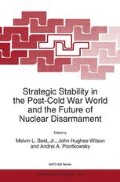Abstract
Is reassurance an effective tool in the maintenance of proliferation stability? The question is studied by means of a simplified simulation model, in which proliferatory moves are decided by cost/benefit considerations, according to a utility function. One participant, called Stabilizer, is ready to reassure potential proliferators by offering a predetermined package, the blocking-payment, designed to encourage them to maintain the status-quo. A conceptual analysis of the model reveals certain weaknesses of reassurance, such as extortion and positive feedback. A quantitative simulation shows, rather surprisingly, that reassurance plays a limited role in combatting proliferation, as long as the costs and payments involved are reasonable. Still, reassurance is important, because no alternative mechanism seems more promising, given a non-belligerent, multi-polar world (with a leading superpower)
Access this chapter
Tax calculation will be finalised at checkout
Purchases are for personal use only
Preview
Unable to display preview. Download preview PDF.
References
Adler E. (1992): “Arms Controls, Disarmament and National Security: A thirty Year Retrospective and a New Set of Anticipations;” in Adler E. (ed): The International Practice of Arms Control; The Johns Hopkins University Press, Baltimore (Md), 1992, pp. 1–20.
Betts R. K. (1993): Paranoids, Pygmies, Pariahs and Nonproliferation Revisited;” Security Studies, Vol. 2 No. 3/4, Spring/Summer 1993.
Brito D. L. and M. D. Intriligator (1993): “The economic and Political Incentives to Acquire Nuclear Weapons;” Security Studies, Vol. 2 No. 3/4, Spring/Summer 1993.
Godwin P. H. B. and J. J Schulz (1994): “China and Arms Control: Transition in East Asia;” Arms Control Today; Vol. 24, No. 9, Nov. 1994, pp.7–11. 330 Political Issues; D.C. Heath and Co. Lexington (Mass.), 1983.
Harrison S. S. (1994): “The North-Korean Nuclear Crisis: From Stalemate to Breakthrough;” Arms Control Today; Vol. 24, No. 9, Nov. 1994, pp. 18–20.
Mearsheimer J. J. (1990): “Back to the Future: Instability in Europe After to the Cold War;” International Security; Vol. 15, No. 1, Summer 1990, pp. 5–56.
Mearsheimer J. J. (1995): “The False Promise of International Institutions;” International Security; Vol. 19 No. 3, Winter 1994–5, pp. 5–49.
Melissen J. (1994): “Nuclearizing NATO, 1957–1959: the ‘Anglo-Saxons’,nuclear sharing and the fourth country problem;” Review of International Studies; No. 20, 1994, pp. 253–275.
OTA (1993): Proliferation of Weapons of Mass Destruction: Assessing the Risks; U.S. Congress, Office of Technology Assessment, OTA-ISC-559, U.S. Government Printing Office, Washington DC, August 1993.
Roberts B. (1993): “from Nonproliferation to Anti-proliferation;” International Security; Vol. 18, No. 1, Summer 1993, pp. 139–173.
Sagan S. D. (1994): “The Perils of Proliferation: Organization Theory, D.terrence Theory, and the Spread of Nuclear Weapons;” International Security; Vol. 18, No. 4, Spring 1994, pp. 66–107.
Schelling T.C. (1992): “The Thirtieth Year;” in Adler E. (ed): The International Practice of Arms Control; The Johns Hopkins University Press, Baltimore (Md), 1992, pp. 21–32.
Author information
Authors and Affiliations
Editor information
Editors and Affiliations
Rights and permissions
Copyright information
© 1995 Springer Science+Business Media Dordrecht
About this chapter
Cite this chapter
Amit, I. (1995). Stability, Reassurance and Non-Proliferation. In: Best, M.L., Hughes-Wilson, J., Piontkowsky, A.A. (eds) Strategic Stability in the Post-Cold War World and the Future of Nuclear Disarmament. NATO ASI Series, vol 3. Springer, Dordrecht. https://doi.org/10.1007/978-94-015-8396-1_22
Download citation
DOI: https://doi.org/10.1007/978-94-015-8396-1_22
Publisher Name: Springer, Dordrecht
Print ISBN: 978-90-481-4642-0
Online ISBN: 978-94-015-8396-1
eBook Packages: Springer Book Archive

